
Nottingham is a city and unitary authority area in Nottinghamshire, England. Part of the East Midlands region, it is 128 miles (206 km) north of London, 44 miles (71 km) south of Sheffield, 45 miles (72 km) northeast of Birmingham. Nottingham has links to the legend of Robin Hood and to the lace-making, bicycle, and tobacco industries. It was granted its city charter in 1897, as part of Queen Victoria's Diamond Jubilee celebrations. Nottingham is a tourist destination; in 2018, the city received the second-highest number of overnight visitors in the Midlands and the highest number in the East Midlands.

The East Midlands is one of nine official regions of England at the first level of ITL for statistical purposes. It consists of Derbyshire, Leicestershire, Lincolnshire, Northamptonshire, Nottinghamshire and Rutland. The region has an area of 15,627 km2 (6,034 sq mi), with a population over 4.5 million in 2011. The most populous settlements in the region are Derby, Leicester, Lincoln, Mansfield, Northampton and Nottingham. Other notable settlements include Boston, Chesterfield, Corby, Grantham, Hinckley, Kettering, Loughborough, Newark-on-Trent, Skegness, Wellingborough, and Worksop.
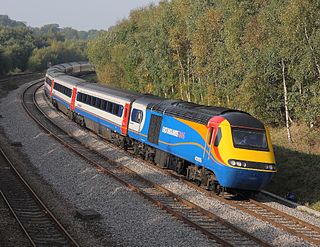
The Midland Main Line is a major railway line in England from London to Nottingham and Sheffield in the north of England. The line is under the Network Rail description of Route 19; it comprises the lines from London's St Pancras station via Leicester, Derby/Nottingham and Chesterfield in the East Midlands.
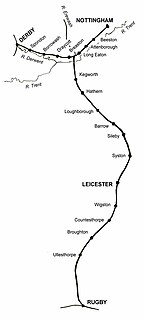
The Midland Counties' Railway (MCR) was a railway company in the United Kingdom which existed between 1839 and 1844, connecting Nottingham, Leicester and Derby with Rugby and thence, via the London and Birmingham Railway, to London. The MCR system connected with the North Midland Railway and the Birmingham and Derby Junction Railway in Derby at what become known as the Tri Junct Station. The three later merged to become the Midland Railway.

Sheffield station, formerly Pond Street and later Sheffield Midland, is a combined railway station and tram stop in Sheffield, England, and the busiest station in South Yorkshire. Adjacent is Sheffield station/Sheffield Hallam University Sheffield Supertram stop. In 2017–18, the station was the 43rd-busiest in the UK, and the 15th-busiest outside London.
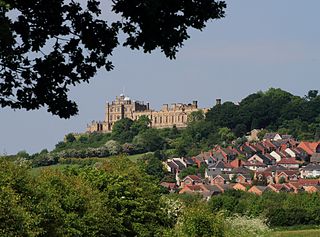
Bolsover is a market town and the administrative centre of the Bolsover District, Derbyshire, England. It is 145 miles (233 km) from London, 18 miles (29 km) from Sheffield, 26 miles (42 km) from Nottingham and 27 miles from Derby. It is the main town in the Bolsover district.

The Park Estate is a private residential housing estate to the west of Nottingham city centre, England. It is noted for its Victorian architecture, although many of the houses have been altered, extended or converted into flats. The estate uses gas street lighting, which is believed to be one of the largest networks in Europe.
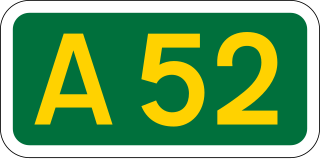
The A52 is a major road in the East Midlands, England. It runs east from a junction with the A53 at Newcastle-under-Lyme near Stoke-on-Trent via Ashbourne, Derby, Stapleford, Nottingham, West Bridgford, Bingham, Grantham, Boston and Skegness to the east Lincolnshire coast at Mablethorpe. It is approximately 147 miles (237 km) long.

Castle Donington is a market town and civil parish in Leicestershire, England, on the edge of the National Forest close to East Midlands Airport.
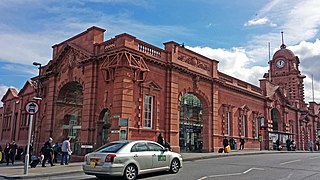
Nottingham station, briefly known as Nottingham City and for rather longer as Nottingham Midland, is a railway station and tram stop in the city of Nottingham. It is the principal railway station of Nottingham. It is also a nodal point on the city's tram system, with a tram stop that was originally called Station Street but is now known as Nottingham Station.

Chesterfield railway station serves the town of Chesterfield in Derbyshire, England. It lies on the Midland Main Line. Four tracks pass through the station which has three platforms. It is currently operated by East Midlands Railway.

Derby railway station is a main line railway station serving the city of Derby in Derbyshire, England. Owned by Network Rail and managed by East Midlands Railway, the station is also used by CrossCountry services and two daily Northern services.

Matlock Railway Station is a railway station owned by Network Rail and managed by East Midlands Railway in the Derbyshire Dales town of Matlock, Derbyshire, England. The station is the terminus of both the Derwent Valley Line from Derby and Peak Rail who operate heritage services to Rowsley South. Both lines are formed from portions of the Midland Railway's former main line to Manchester Central. Through running is technically possible but is not done in normal service.

Beeston railway station is a Grade II listed railway station on the Midland Main Line which serves the town of Beeston in Nottinghamshire, England. It lies 3.2 miles (5.1 km) south-west of Nottingham railway station, and 750 metres (0.5 mi) south-east of Beeston transport interchange for local buses and Nottingham Express Transit trams. The station is managed by East Midlands Railway.

Longport railway station is a station serving the areas of Longport, Middleport, Tunstall and Burslem, all districts in the northern part of Stoke-on-Trent, England. The station is served by trains on the Crewe to Derby Line, which is also a community rail line known as the North Staffordshire line. The station also has two trains a day on the Stoke-on-Trent to Manchester Piccadilly line. The station is owned by Network Rail and managed by East Midlands Railway.

BBC East Midlands is the BBC English Region covering Derbyshire, Leicestershire, Nottinghamshire, Rutland, South Kesteven in Lincolnshire and some northern parts of Northamptonshire.

Many of the tunnels of Nottingham were built by three railway companies in and around Nottingham, England because their lines crossed substantial hills. The companies were the Great Northern Railway (GNR), the Great Central Railway (GCR), and the Nottingham Suburban Railway.

Watson Fothergill was a British architect who designed over 100 unique buildings in Nottingham in the East Midlands of England, his influences were mainly from the Gothic Revival and Old English vernacular architecture styles.

Thomas Chambers Hine was an architect based in Nottingham.

The Castle Donington line also known as Weston On Trent Branch Railway is a railway line in Derbyshire, England, that runs between Stenson Junction in the west and Sheet Stores Junction in the east. There are no passenger services that serve this line regularly but passenger services are occasionally routed across it. Regular passenger services are routed via Derby. The line is regularly used by freight trains and serves the East Midlands gateway freight interchange. There are no current passenger stations on the line which previously served stations at Castle Donington and Weston-on-Trent and also linked to the Melbourne Line.




















